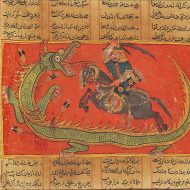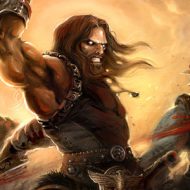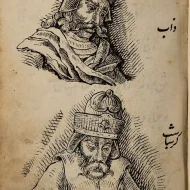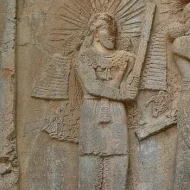Garshasp : The Persian Hero
Listen
At a glance
| Description | |
|---|---|
| Origin | Iranian Mythology |
| Classification | Mortals |
| Family Members | Zaveh (Father), Rudaba (Mother), |
| Region | Iran |
| Associated With | Bravery. Battle, Fighting |
Garshasp
Introduction
Garshasp’s presence is woven into two distinct yet interconnected narratives within Iranian mythology. In the ancient Avesta, the foundational scripture of Zoroastrianism, he assumes the name Kərəsāspa—a formidable warrior and priest dedicated to serving Ahura Mazda, the supreme god. In this sacred text, his role unfolds as a valiant defender against the forces of evil, engaging in fierce battles against demons to preserve the cosmic order.
However, it is within the pages of the epic poem Shahnameh, crafted by the illustrious poet Ferdowsi, that Garshasp ascends to true legendary status. Cast as the final Shah of the Pishdadian dynasty, a lineage of mythical kings believed to have ruled Iran before the advent of the Achaemenid Empire, Garshasp’s narrative unfolds with grandeur. Despite the brevity of his reign, it leaves an indelible mark characterized by both prosperity and tragedy, establishing him as an enduring symbol of strength and sacrifice.
Physical Traits
Garshasp is commonly portrayed as a stalwart and valiant warrior, a towering figure depicted in various miniatures engaging in epic feats such as slaying dragons and confronting sagsars wielding tree branches as weapons. His imposing presence is captured in artistic representations, showcasing a broad-shouldered and muscular physique. The fierceness etched onto his countenance reflects the numerous battles he has faced and the burdens he has shouldered.
Garshasp’s visual portrayal encompasses distinctive features—an impressive mane of flowing hair and a robust beard framing his determined face. His eyes, radiating wisdom earned through adversity, convey the depth of his character. Clad in the regalia of a warrior king, his armor is meticulously crafted from the finest metals, adorned with intricate designs that tell tales of his heroic exploits. In his hand, he brandishes a formidable mace, capable of crushing bones and shattering shields, a symbol of his martial prowess.
This depiction paints Garshasp as the embodiment of the ideal hero—a physical manifestation of unparalleled strength and unwavering resolve. Descriptions conjure an image of a Herculean figure, with muscles rippling with power, and an aura exuding confidence. The battle scars that adorn his visage serve as a testament to his unyielding tenacity in the face of adversity, further solidifying his status as a legendary and indomitable hero.
Family
Garshasp, known as Kərəsāspa in Avestan and Kirsāsp in Middle Persian, traces his ancestry to the esteemed Sāma family as the son of Θrita. Θrita, initially a deity, bestows upon Garshasp a lineage deeply rooted in Iranian mythology. Zaveh, Garshasp’s father, hails from the line of Kay Kayus, a legendary king celebrated for his wisdom and commitment to justice. The maternal side of Garshasp’s heritage is equally illustrious, with his mother, Rudaba, being the daughter of Sam—a mythical hero renowned for slaying the formidable demon Simurgh.
This intricate lineage weaves a narrative that imbues Garshasp with a profound sense of destiny. Born into a family of mythical heroes and wise kings, he shoulders the responsibility of upholding the legacy of his forefathers and safeguarding the Iranian people. The union of divine ancestry and heroic bloodlines shapes Garshasp into a figure destined for greatness, emphasizing his role as a protector and bearer of the rich cultural and mythical heritage of Iran.
Other names
The name of Garshasp undergoes linguistic variations across different periods, taking the Avestan form as Kərəsāspa and transforming into Kirsāsp in Middle Persian. Throughout his extensive journey, Garshasp assumes diverse names, each encapsulating distinct facets of his character. In the Avesta, he is known as Kərəsāspa, translating to “camel-killer,” a title that stands as a testament to his unyielding strength and ferocious nature. In the Shahnameh, he is referred to as Garshasp or Garshasb, names resonating with his affiliation to the Pishdadian dynasty. Additionally, he carries the epithet “Divband,” signifying “demon-binder,” underscoring his pivotal role as a protector against the forces of evil in various narratives.
Powers and Abilities
Garshasp emerges as a revered dragonslayer in the Avesta, celebrated for his unmatched bravery and strength that enabled him to vanquish formidable monsters such as the Gandarəβa and the Aži Sruvara. The Aži Sruvara, a dragon with imposing features, including horns, immense eyes, and ears, boasted teeth that gruesomely displayed the remains of its consumed victims. This monstrous creature was so colossal that Kərəsāspa traversed its vast length for half a day before reaching its head, where he ultimately delivered a fatal blow with his mighty mace, securing victory.
Another formidable adversary confronted by Kirsāsp was the Gandarəβa, known as Gandarw in Middle Persian. This colossal sea-dwelling creature had the capacity to engulf twelve provinces in a single gulp, its towering stature reaching the sun. Engaged in a nine-day battle, Kirsāsp emerged triumphant by flaying the Gandarw and binding it with its own skin after being pulled into the ocean.
In the realm of Zoroastrian eschatology, Garshasp’s resurrection is foretold, with his divine mission centered around slaying the monstrous Zahhak. As the prophesied end of the world unfolds and the imprisoned Dahāg breaks free from his chains on Mount Damāvand, Kirsāsp, having been safeguarded from decay, is resurrected to confront Dahāg and safeguard the remaining two-thirds of the world from the creature’s devastation.
Garshasp’s prowess extends beyond mere physical strength, encompassing a repertoire of supernatural abilities that elevate him to a truly formidable figure. His superhuman strength enables him to grapple with monstrous adversaries and dismantle structures with sheer force. Possessing extraordinary speed and agility, he effortlessly outmaneuvers swift opponents, and his unmatched resilience allows him to endure blows that would incapacitate any ordinary mortal. Yet, perhaps his most potent attribute is his unwavering courage—a resolute spirit that empowers him to confront challenges without succumbing to fear.
Among Garshasp’s legendary exploits, the battle against the dragon Biabangala stands out. This monstrous serpent, unleashing fiery terror upon the countryside and preying on the innocent, provoked Garshasp’s righteous anger. In an epic clash that reverberated through the foundations of the earth, Garshasp confronted the beast with his mace raised high, ultimately striking it down and earning the gratitude of the people, solidifying his reputation as a stalwart protector of the vulnerable.
Modern Day Influence
Garshasp’s courageous exploits and legendary feats of monster-slaying have etched an enduring mark on Iranian culture and literature. Through the ages, his tales persist, serving as an unending wellspring of inspiration for countless works of art and literature. The resonance of Garshasp’s legacy is deeply embedded in the fabric of Iranian culture, where his name reverberates through proverbs and folktales, and his visage embellishes murals and sculptures. Poets, writers, and artists draw inspiration from the heroic figure of Garshasp, continually reimagining and retelling his story to captivate and resonate with modern audiences.
Related Images
Frequently Asked Questions
What is lorem Ipsum?
I am text block. Click edit button to change this text. Lorem ipsum dolor sit amet, consectetur adipiscing elit. Ut elit tellus, luctus nec ullamcorper mattis, pulvinar dapibus leo.
What is lorem Ipsum?
I am text block. Click edit button to change this text. Lorem ipsum dolor sit amet, consectetur adipiscing elit. Ut elit tellus, luctus nec ullamcorper mattis, pulvinar dapibus leo.
What is lorem Ipsum?
I am text block. Click edit button to change this text. Lorem ipsum dolor sit amet, consectetur adipiscing elit. Ut elit tellus, luctus nec ullamcorper mattis, pulvinar dapibus leo.
What is lorem Ipsum?
I am text block. Click edit button to change this text. Lorem ipsum dolor sit amet, consectetur adipiscing elit. Ut elit tellus, luctus nec ullamcorper mattis, pulvinar dapibus leo.
What is lorem Ipsum?
I am text block. Click edit button to change this text. Lorem ipsum dolor sit amet, consectetur adipiscing elit. Ut elit tellus, luctus nec ullamcorper mattis, pulvinar dapibus leo.







